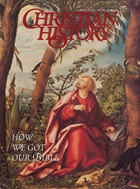
We have about 5,000 Greek manuscripts that contain at least a portion of the New Testament, but in many places, they do not agree exactly on wording. And most of the earliest copies are 100 to 200 years later than the originals. From a historical perspective, how accurately does the modern Bible reflect the content of the original manuscripts?
To answer this question, Christian History talked with Bruce Metzger, professor emeritus of Princeton Theological Seminary. Dr. Metzger has had a distinguished career in biblical studies. His most important work was heading the translation committee for the New Revised Standard Version (1990).
Christian History: For most of its long history, the Bible was copied by hand. How easy was it for a mistake to enter into this process?
Bruce Metzger: Whenever something is copied by hand, frailties of human eyesight enter in, particularly if that document is old and some ink has faded. Copying is also long, tedious work. It would take a scribe several months to copy just one Gospel. In some secular Greek manuscripts, scribes left a note at the end that indicates the patient labor involved: “As the traveler rejoices to see the home country, so the scribe rejoices to see the end of a manuscript!”
The invention of eyeglasses around 1375 certainly helped reduce the number of mistakes. And the invention of printing with movable type in 1456 assured production of duplicate copies. But prior to that, for over a thousand years, everything was done by hand, and the more times an ancient text was copied, the more chance for errors to creep in.
How reliable are the Greek and Hebrew manuscripts we have today?
The earlier copies are generally closer to the wording of the originals. The translators of the 1611 King James Bible, for instance, used Greek and Hebrew manuscripts from the twelfth and thirteenth centuries. Today Bible translators have access to Greek manuscripts from the third and fourth centuries and Hebrew manuscripts from the era of Jesus.
We even have the Rylands Papyrus, just a torn page with a few verses from John 18, that we can date between a.d. 100 and 150. So today we have access to a text of the Old and New Testaments that is more basic, more fundamental, less open to charges of scribal error or change.
How can we date such manuscripts accurately?
Since manuscripts rarely have dates on them, we must judge the date by the handwriting. Handwriting styles differ with the times. So we compare the handwriting of a manuscript with that of deeds and bills of sale and other documents that do include dates. In addition, sometimes a scribal note in the margin or on the dedication page gives away the period in which the manuscript was copied.
Most of the earliest surviving New Testament manuscripts are 100 to 200 years later than the originals. Is that cause for concern?
By contrast, our copies of other ancient writings, like those of Virgil or Homer, are often many hundreds of years later than their originals.
In some of those writings, we have only one copy! The New Testament, on the other hand, has many copies.
Over the centuries of transmission, have scribal errors touched any core Christian doctrines?
No key doctrine of the Christian faith has been invalidated by textual uncertainty.
On the other hand, some passages have been affected. For example, take Mark 9:29. Jesus is explaining how he was able to cast out a demon, and in the earliest manuscripts, he is quoted as saying, “This kind can come out only by prayer.” In the Greek manuscripts the KJV translators used, the two words and fasting are tacked on. I do not think that is an earth-shaking difference, but it is typical of the kind of changes we are talking about.
How would such a change have taken place?
By studying manuscript history, we see that the words and fasting were inserted between 300 and 600. These were the years of the desert fathers and the birth of monasticism. The number of official fast days was increasing, and the regimens of fasting were becoming more strict. Probably a devout scribe, himself part of a fasting tradition, believed that Jesus must have meant to include “and fasting,” so he included the two words.
Some Bibles list three endings for the Gospel of Mark. How should we understand these?
The earliest Greek, Syriac, Coptic, Armenian, and Latin manuscripts end the Gospel of Mark at 16:8: “The women said nothing to anyone, for they were afraid.” That does not sound like an appropriate ending for a book of good news, so some early scribes, undertaking their own research, added what they thought would be appropriate endings.
A few later manuscripts add just two or three verses to this abrupt ending, but most contain a longer ending, what we now number as verses 9 to 20. We can tell by examining the vocabulary that these endings were not written by Mark. So translators often put them in brackets or as a long footnote.
Why not just keep them out of the Bible?
Many translators, including myself, consider verses 9 through 20 to be a legitimate part of the New Testament.
In the third and fourth centuries, when church fathers were deciding which books should be included in the New Testament, these verses were already in the copies of Mark that most of them were using. In other words, the early church considered verses 9 through 20 to be a credible account of the Resurrection.
Though these verses were not written by Mark, I believe we have here a fifth evangelical witness to the resurrection of Jesus.
You mentioned Coptic, Armenian, and Latin manuscripts—It sounds as though the Bible was being rapidly translated from the beginning.
Not really. By the year 600, the Gospels had been translated into only eight languages. By the time of the Reformation, there were Bibles or portions of it translated into only 33 languages—out of a total of about 6,000 languages! It is discouraging to see how slow the church was in providing translations of the Holy Scriptures.
When did that change?
Not until the nineteenth and twentieth centuries, with the expansion of the Protestant missionary movement. According to the American Bible Society, at the end of 1993, the entire Bible has been translated into 329 languages, and at least one book of it has been translated into 2,009 languages. That means, of course, that a good many languages still lack even one book of the Bible.
On the other hand, since 85 percent of the world speaks one of these 2,009 languages, the vast majority of people have access to at least one book. The Wycliffe Bible Translators and others have done wonderful work in reducing many languages to written form and then translating the Bible into them.
In terms of the English Bible, it seems that the last few decades have been extraordinary years of translation.
Between 1952, when the Revised Standard Version came out, and 1990, when the New RSV came out, there were 27 complete translations of the Bible in English published, plus another 25 New Testament translations—all within 38 years. That is unprecedented in the history of translation.
Part of this activity is related to manuscript discoveries; when we discover still more ancient biblical manuscripts or ancient secular manuscripts that shed light on ancient languages, people naturally want that information reflected in their Bibles.
Also, many different religious groups—Roman Catholics, moderate and conservative Protestants, and Jews—have each wanted their own translations.
In addition, there is the economic factor: the Bible is a best-seller, so many publishing companies have been inclined to sponsor and publish new versions.
With so many Bible translations available, are English-speaking people more biblically literate than in the past?
I am not sure. In the first 1,500 years of the church’s history, literacy was low, and there were not many copies of the Scriptures available to read. Of the 5,000 Greek manuscripts of the New Testament now available, only 59 have all 27 books. That means that few congregations, and far fewer individuals, had access to all of the New Testament, let alone the whole Bible.
Today we live in a culture of relatively high literacy, but we also have many, many newspapers, magazines, and books to read. In addition, radio, television, and the movies are a major distraction from reading. In some ways, then, people who can read probably are not as familiar with the Bible as those who could read in previous eras.
You’ve spent the bulk of your 80 years immersed in this one Book. What has kept you energized?
The very fact that the Bible is inspired to be Holy Scripture. I read it, and I am inspired by the inspired words of the writers. I also find it interesting as literature. It is productive for life, for the church, for the individual believer. I thank God that I am still able to study its passages. As long as I am able, I want to follow the motto that is found in a 1734 edition of the Greek New Testament: “Apply yourself totally to the text; apply the text totally to yourself.”
Copyright © 1994 by the author or Christianity Today/Christian History magazine.
Click here for reprint information on Christian History.

Support Our Work
Subscribe to CT for less than $4.25/month





























